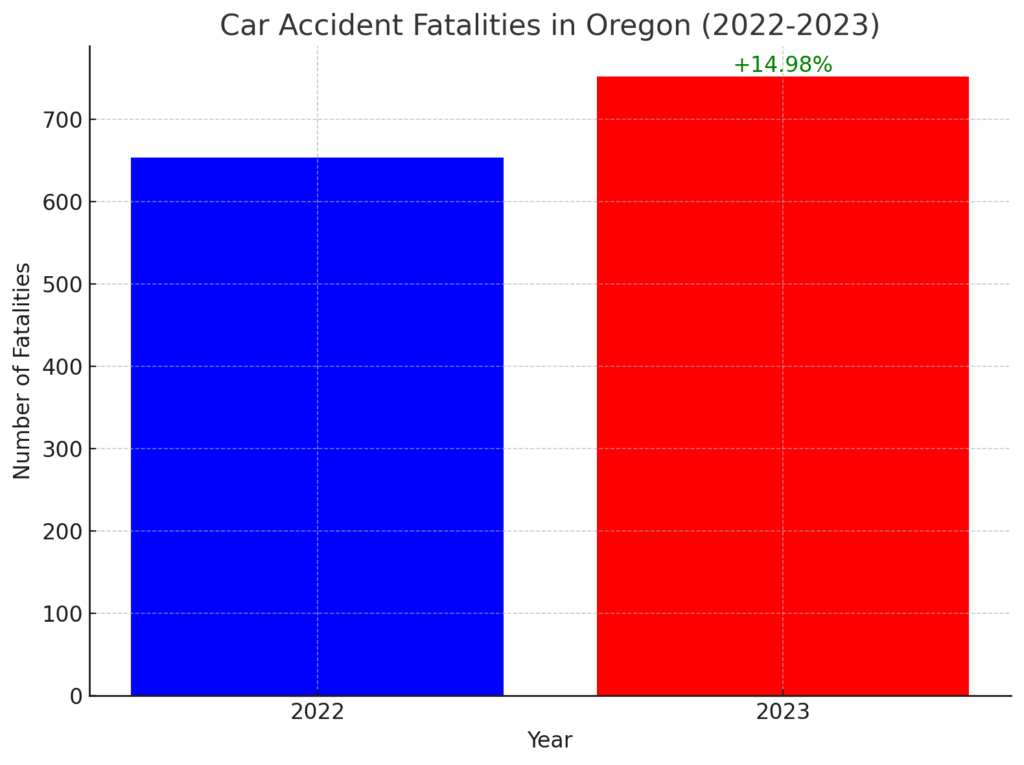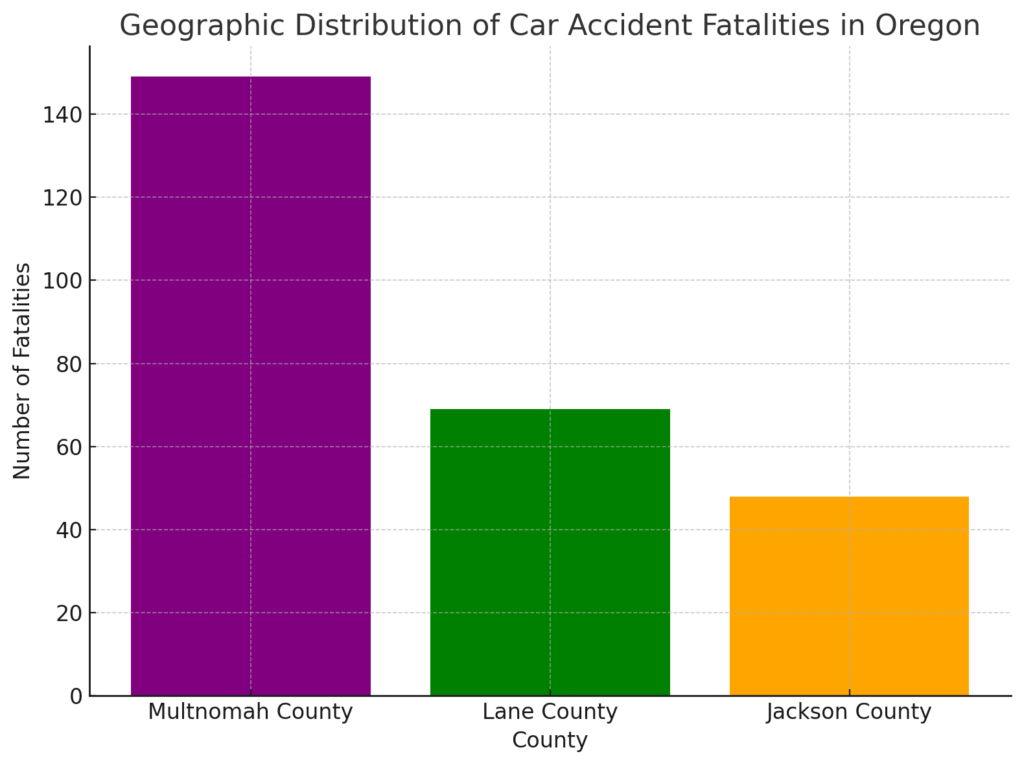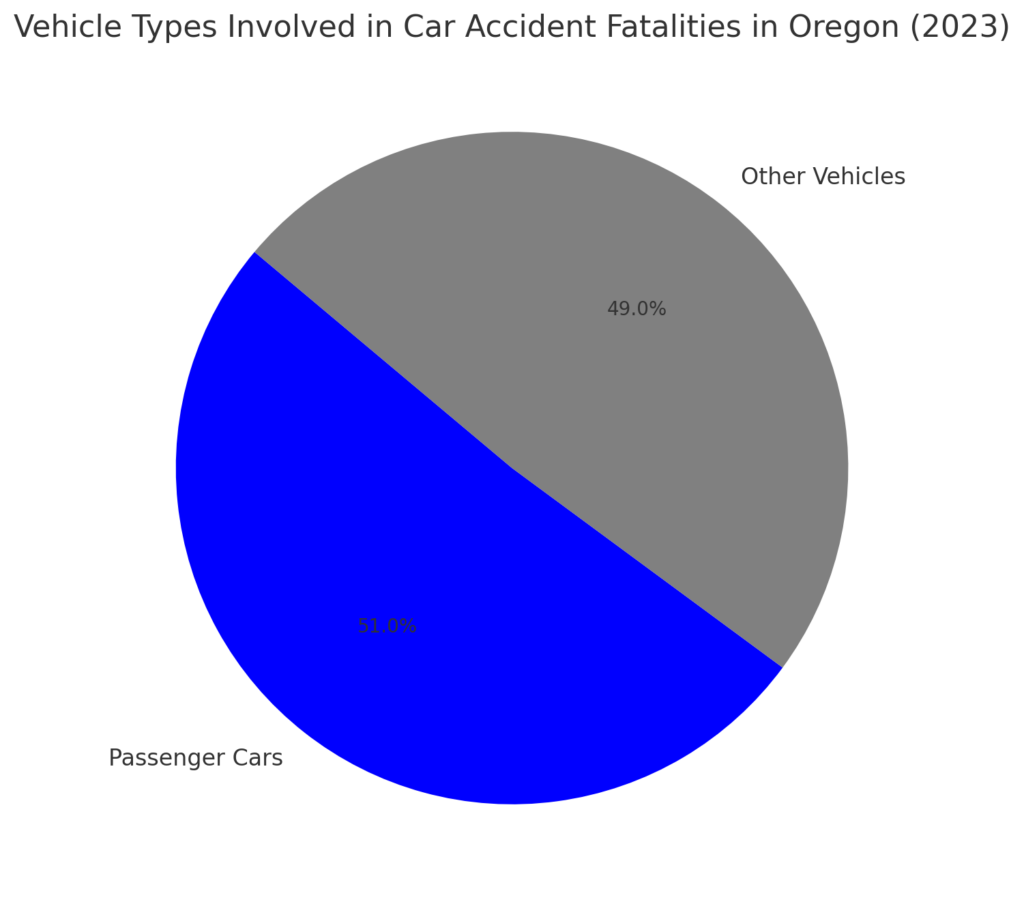Fatal car accidents in Oregon have witnessed a concerning increase in recent years. The data reveals a worrying upward trend, indicating the urgency to address the factors contributing to these tragic incidents. Understanding the reasons behind this rise is crucial for implementing targeted preventive measures.
In total, there were 752 car accident fatalities in Oregon in 2023, up from 654 in 2022. This marks a 15% increase year-over-year, which is cause for serious concern. Moreover, Oregon now ranks 24th nationally for car accident fatalities per capita, up from 33rd in 2022.

Here is the graph depicting car accident fatalities in Oregon for the years 2022 and 2023.
Key Findings and Trends
After analyzing the data, there are three major findings that are worth noting:
- Firstly, the majority of car accident fatalities happen on rural roads, and speed is often a contributing factor;
- Secondly, distracted driving remains a significant issue, with the use of mobile phones while driving is a common cause;
- Lastly, there are substantial disparities in car accident fatalities, with certain communities being more impacted than others.
Rural roads have specific characteristics that contribute to accidents. Speed limits are often higher, and drivers may feel more emboldened to take risks when there are fewer cars around. Furthermore, these roads may not be adequately maintained, which can create hazards like potholes. Distracted driving requires a more comprehensive approach, as it is still a prevalent issue despite being illegal in many places.
Finally, low-income and rural communities are disproportionately affected by car accident fatalities, as they often lack access to public transportation and other resources that can help mitigate risk.
Comparisons to Previous Years
The current state of fatal car accidents in Oregon presents a disheartening and concerning trend when compared to previous years. Through careful analysis of historical data, we can uncover valuable insights into the causes behind the escalating fatality rates. This comparative approach enables us to evaluate the effectiveness of existing safety measures while identifying specific areas that demand immediate attention.
The surge in fatalities witnessed in 2023 is indicative of a larger pattern that has been developing over the past decade in Oregon. Although there have been occasional fluctuations in certain years, the overall trend has been an upward trajectory in car accident deaths. This year’s figures not only reveal a substantial increase in absolute numbers but also a significant rise in deaths per capita, intensifying the urgency of addressing the issue.
One plausible factor contributing to the rise in fatalities is the state’s growing population. With an influx of residents migrating to Oregon, there is a proportional increase in the number of drivers on the roads, inherently elevating the risk of accidents. However, it is important to consider other potential factors as well, such as shifts in weather patterns or an upswing in tourism, which may also contribute to the overall increase in fatal car accidents.

National Context and Rankings
Despite not having the highest ranking for car accident fatalities per capita in the country, Oregon’s position is still a cause for concern. The year 2023 witnessed a troubling surge in car accident fatalities nationwide, and many states, including Oregon, are experiencing similar trends. Factors such as rural roads, distracted driving, and speeding contribute significantly to this concerning pattern.
As a response to this alarming situation, there is a growing conversation surrounding road safety improvement and the prevention of further tragedies. One potential solution is to prioritize investments in enhanced infrastructure, especially in rural areas where roads may be less safe. Additionally, there is a pressing need for increased education and awareness campaigns addressing distracted driving and other risky behaviors. Furthermore, exploring technological advancements, such as the implementation of automated speed limiters or other safety features in vehicles, holds promise in making driving safer.
Overall, while the rise in car accident fatalities in Oregon demands attention, it is crucial to recognize that proactive measures can be taken to mitigate risks. Through collaborative efforts between policymakers, communities, and drivers, the roads can be made safer for everyone.
Key Points:
- Oregon’s ranking for car accident fatalities per capita is a concern, although not the highest in the nation;
- A nationwide increase in car accident fatalities has been observed in 2023, with similar trends seen in many states;
- Factors like rural roads, distracted driving, and speeding contribute to the overall rise in car accidents;
- Proposed solutions include investing in improved infrastructure, particularly in rural areas, increasing education and awareness campaigns, and exploring technological advancements for safer driving;
- Collaboration between policymakers, communities, and drivers is essential in reducing risks and enhancing road safety.
Three Main Causes of Car Accident Fatalities in Oregon
As mentioned, distracted driving is a major factor in car accident fatalities in Oregon. Many people believe that texting and driving is the primary issue, but in reality, it’s a broader problem. Anything that takes a driver’s eyes off the road and hands off the wheel can be considered distracting, from eating to talking to a passenger. Given the ubiquity of smartphones and the growing use of in-car technologies, it’s no surprise that we’re seeing more distracted driving-related accidents.
Combating this problem requires a multi-faceted approach involving targeted public awareness initiatives, legislative measures, and rigorous enforcement to discourage such driving behaviors.
Speeding and Reckless Driving
Speeding and reckless driving are two of the single biggest causes of car accident fatalities in Oregon. Speed limits exist for a reason, and when drivers ignore them, they put themselves and others at risk. The same goes for reckless driving behaviors like tailgating, weaving in and out of traffic, or failing to signal before turning.
Drivers who exceed posted speed limits or engage in aggressive maneuvers jeopardize their safety and that of others sharing the road. Effectively addressing this issue necessitates strict enforcement of speed limits, enhanced driver education programs, and comprehensive public awareness campaigns to promote responsible driving behavior.

Driving Under the Influence
Despite strict DUI laws in Oregon, driving under the influence remains a major cause of car accident fatalities. Alarming statistics underscore the prevalence of accidents involving drivers under the influence, highlighting the urgent need for stricter enforcement of laws and comprehensive educational campaigns to raise awareness about the dangers of impaired driving.
That said, alcohol-related crashes were responsible for 27% of all traffic-related fatalities in 2023. While progress has been made in recent years, there is still more work to be done to prevent drunk driving.
Additional Causes
The table below presents additional factors that contribute to car accident fatalities in the state of Oregon. It highlights the impact of weather-related accidents, the role of road infrastructure and conditions, and the vulnerability of road users.
| Category | Information |
|---|---|
| Weather-Related Accidents | Oregon’s rainy and icy conditions can create hazardous driving conditions. Sudden changes in road conditions due to weather can catch drivers off guard. Wet and slippery roads make it harder for drivers to stop quickly, increasing the risk of accidents. |
| Road Infrastructure | Poor road conditions in rural areas contribute to car accident fatalities. Narrow lanes and poor visibility on rural roads pose risks to drivers. Lack of guardrails on rural roads increases the likelihood of accidents. Unfamiliarity of some drivers with rural roads leads to confusion and poor decision-making. |
| Vulnerable Road Users | Pedestrians and bicyclists are highly vulnerable on Oregon’s roads. Fatal accidents often involve pedestrians and bicyclists. Analyzing data and identifying patterns can aid in developing targeted safety measures for vulnerable road users. |
| Infrastructure | Well-designed crosswalks improve safety for pedestrians. Protected bike lanes provide a safer environment for bicyclists. Improved signage enhances awareness and reduces the likelihood of accidents. |
Demographics and Car Accident Fatalities
Looking at the age and gender breakdown of car accident fatalities, there are some striking patterns:
- Men are significantly more likely to be involved in car accidents than women, representing 63% of all fatalities in Oregon in 2023;
- Young adults between the ages of 20-24 and 25-29 are the age groups most likely to be involved in car accidents.
Geographic Distribution of Fatalities
As mentioned, rural roads are particularly dangerous when it comes to car accident fatalities. Additionally, some counties saw significantly more fatalities than others:
- Multnomah County (including Portland) had the highest number of car accident fatalities with 149;
- The second place belongs to Lane County with 69 fatalities;
- The third comes Jackson County with 48 fatalities.

Here is the graph illustrating the geographic distribution of car accident fatalities in Oregon across three counties.
Vehicle Types Involved in Fatalities
Another important factor to consider is which types of vehicles are involved in car accident fatalities:
- In 2023, passenger cars were the most common vehicle type, accounting for 51% of all fatalities;
- Pickup trucks were the second most common, followed by SUVs, motorbikes, and commercial trucks.

Here is the corrected pie chart representing the distribution of vehicle types involved in car accident fatalities in Oregon for the year 2023.
Prevention and Safety Measures
One key way to prevent car accidents is to strengthen and enforce traffic laws and regulations. In recent years, Oregon has taken a number of steps to improve road safety, including lowering speed limits in high-risk areas and cracking down on distracted driving.
Additionally, the state has invested in improving road infrastructure, including adding more guardrails on rural roads.
The table below presents a range of effective strategies and approaches aimed at reducing car accident fatalities and enhancing road safety, including impactful public awareness campaigns, tech innovations, and infrastructure improvements.
| Category | Information |
| Public Awareness Campaigns | Oregon has launched public awareness campaigns to address drunk driving, distracted driving, and aggressive driving. Various mediums such as social media, billboards, and TV ads are utilized to raise awareness about the risks and promote safe driving habits. |
| Technological Innovations | Modern cars are equipped with automatic braking systems that can prevent crashes by applying brakes in emergency situations. Features like lane departure warnings and blind spot detection help drivers stay aware of their surroundings and avoid accidents. |
| Infrastructure Improvements | Improving infrastructure on rural roads plays a crucial role in reducing car accident fatalities. Enhancements can include the addition of guardrails, widening of lanes, and improved road signage. Investments in public transportation in rural areas can reduce the number of cars on the road, thus lowering the risk of accidents. |
Conclusion
While the increase in car accident fatalities in Oregon in 2023 is cause for concern, we hope this analysis has shed light on the major causes, demographic patterns, and potential solutions. It’s clear that there’s a lot of work to be done to improve road safety, from tightening traffic laws to investing in infrastructure. By working together, we can all help make Oregon’s roads safer for everyone.